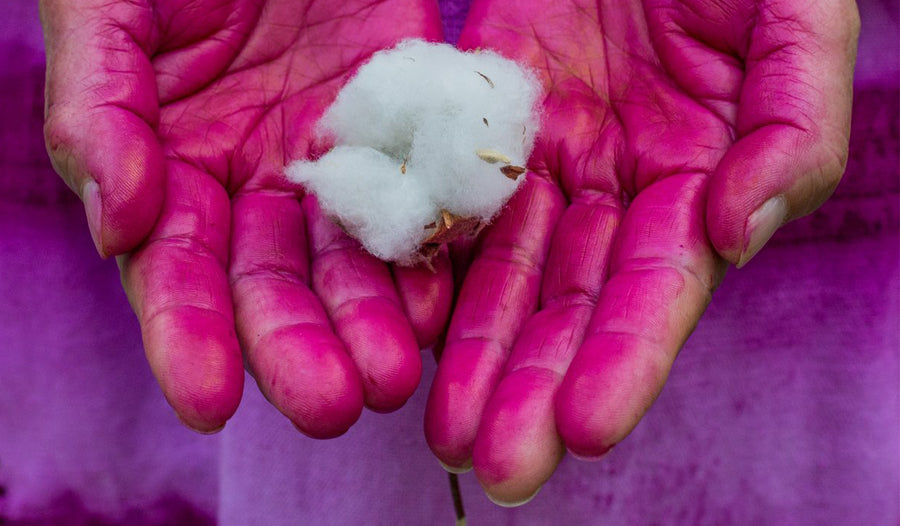
NOHUI Interview

NOHUI is a Mexican organisation that honours the work of traditional textile artisans - valuing and celebrating the people who keep alive the biocultural heritage of their country. We were thrilled that Nohui took part in the Selvedge World Fair 2021 - read on for our interview with the weavers whose products are still available to shop on the Selvedge website.
What do you make?
At NOHUI we honour the work of artisans to keep alive the biocultural heritage of our country. That is why we are committed to teaching and educating about artisanal processes that originate from the sowing of native cotton, which becomes the thread that will be woven on the backstrap looms. Using natural dyes (a large part of them pre-Hispanic and ceremonial, such as the purple snail pansa, the red cochineal and the indigo) and weaving the threads into unique pieces, such as huipiles, cotton and rebozos is what we do. Our products are friendly to the ecosystem and raise awareness about responsible consumption, keeping in mind the sustainable care of our Planet Earth.

How is this craft connected to your heritage or culture?
On the coast of Oaxaca, specifically in San Juan Colorado, Jamiltepec, a Mixtec community on the coast, we are still planting and growing organic cotton in small plots to obtain handmade threads and make traditional clothing for men. These traditional outfits consists of cotton pieces that are still worn on a daily basis and are designated according to the type of cotton for certain hierarchical levels in the community. We are working with these communities of natural growers and dyers to produce the materials for our pieces. We also continue to dye threads with pre-Hispanic and ceremonial natural animal and plant dyes, such as the luxurious purple pansa snail.

What materials do you use? Where are they from and how are they processed?
In the community of San Juan Colorado, ninety percent of the women are dedicated to making traditional clothing on backstrap looms. It is here that native cottons still persist, for example, white, coyuchi and green cotton, the latter two which are in danger of extinction due to high temperatures caused by climate change. We also produce garments with natural dyes, dating from pre-Hispanic times, such as the purple belly snail and the cochineal bug. We are always looking for ways to continue learning and experimenting with new materials, and that is why we decided to take advantage of each of the minerals, dyes and pigments that are produced in the state of Oaxaca and thus offer customers with options that are traditional yet unique to a community that lives on the coast, using elements typical of our state.

What techniques do you use? Where and how did you learn the craft?
For the creation of most of our fabrics, native cotton is grown, which is organic due to the care used in the process of growing the plant. This cotton is made into a thread with the winch, a pre-Hispanic instrument. After this step, the threads are starched with corn gruel so that it does not break when woven with the backstrap loom technique. The ease and flow of techniques is inherited from generation to generation. This is work that identifies us as a people and lives in tune with the space that surrounds us in this region.
Can you tell us about the designs used?
We work with the traditional structure of clothing, which consists of shapes like squares and rectangles. For women, this is the huipil and for men, the cotón (traditional shirt) and calzones (pants). We are also always implementing new colour proposals that are not common in everyday garments within the context of the community, encouraging innovation and exploration despite the traditional methods and designs used.

Can you tell us how your products are economically and environmentally sustainable?
The textiles that we produce are born in the nucleus of the home of each of the master weavers. We do not work with mass production systems and we respect the autonomy of the artisans. Items are made according to free time, after the weavers carry out their household work. That is why in each piece, artisans share a part of their life. In each of our pieces we use fibres of animal origin, such as silk or sheep wool, which are obtained in a respectful way by always keeping in mind that we are part of the same cycle. Our main focus is the organic native cotton, which is grown in a similar way to how our ancestors tended this plant. Today we have a palette of four colours: white, coyuchi (brown), green and red. These little-known cotton fibre colours are protected in our community and today we put it in front of the eyes of the whole world, so that you may know the essence of our community.
Nohui exhibited as part of the Selvedge World Fair 2021. Find out more about their stories on social media @nohui.oax


1 comment
Thank you so much for this article. It is not only inspiring but a huge lesson for us all. Culture, sustainability and the future of our planet is at risk if we do not follow suit and respect our environment and work with nature in a respectful way.